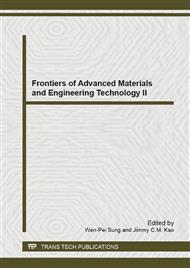[1]
A. Antic, M. Zeljkovic, P. B. Petrovic, A. Zivkovic, J. Hodolic, Experimental analyses and FEM modeling of a cutting tool vibrations, Strojarstvo, Vol. 54, No. 2 (2012), pp.117-125.
Google Scholar
[2]
D. Kovacevic, M. Sokovic, I. Budak, A. Antic, B. Kosec, Optimal finite elements method (FEM) model for the jib structure of a waterway dredger, Metalurgija, Vol. 51, No. 1 (2012), pp.113-116.
Google Scholar
[3]
S. Hloch, A. Ruggiero, Online monitoring and analysis of hydroabrasive cutting by vibration, Advances in Mechanical Engineering, Vol. 2013 (2013), art. no. 894561, ISSN 1687‐8132.
DOI: 10.1155/2013/894561
Google Scholar
[4]
P. Cacko, T. Krenicky, J. Dobransky, Impact of an excessive wear of bearing on the mechatronic devices. Applied Mechanics and Materials, Vol. 460, (2014), pp.99-106.
DOI: 10.4028/www.scientific.net/amm.460.99
Google Scholar
[5]
J. Jurko, A. Panda, Simulation of accompanying phenomena in the cutting zone during drilling of stainless steels. 3rd International Conference on Advanced Computer Theory and Engineering, Proceedings 1 , art. no. 5579026 (2010), p. V1239-V1243.
DOI: 10.1109/icacte.2010.5579026
Google Scholar
[6]
G. Krolczyk, S. Legutko, M. Gajek, Predicting the surface roughness in the dry machining of duplex stainless steel. Metalurgija, Vol. 52, No. 2 (2013), pp.259-262.
Google Scholar
[7]
DAVID Laserscanner: DAVID Professional 3. x Licenses [online] (2009), <http: /www. david-laserscanner. com/>.
Google Scholar
[8]
Meshlab: Download Latest Version V1. 3. 2 [online] (2013), <http: /meshlab. sourceforge. net/>.
Google Scholar
[9]
J. Novak-Marcincin, J. Torok, J. Barna, L. Novakova-Marcincinova, Technology of Perspective Scanning Methods for Realization of 3D Models of Manufacturing Devices. Manufacturing Technology, Vol. 12, No. 13, (2012), pp.186-191, ISSN 1213-2489.
DOI: 10.21062/ujep/x.2012/a/1213-2489/mt/12/2/186
Google Scholar
[10]
J. Novak-Marcincin, J. Torok, J. Barna, M. Janak, L. Novakova-Marcincinova, V. Fecova, Realization of 3D Models for Virtual Reality by Use of Advanced Scanning Methods. In: IEEE International Conference on Cognitive Infocommunications, Kosice, (2012).
DOI: 10.1109/coginfocom.2012.6421957
Google Scholar
[11]
J. Novak-Marcincin, V. Fecova, J. Barna, M. Janak, L. Novakova-Marcincinova, Using of the virtual reality application with the scanning device Kinect for manufacturing processes planning. Manufacturing Technology, Vol. 13, No. 2 (2013).
DOI: 10.21062/ujep/x.2013/a/1213-2489/mt/13/2/215
Google Scholar
[12]
J. Novak-Marcincin, J. Barna, J. Torok, M. Janak, Visual Reconstruction and Optimization of Real Wokplace on the Base of Spatial Digitisation. Applied Mechanics and Materials, Vol. 308 (2013), pp.175-178, ISSN 1662-7482.
DOI: 10.4028/www.scientific.net/amm.308.175
Google Scholar
[13]
J. Novak-Marcincin, V. Fecova, L. Novakova-Marcincinova, J. Torok, J. Barna, Verification of Machine Position in Production Plant with Use of Virtual Reality Technology. Applied Mechanics and Materials, Vol. 308, (2013).
DOI: 10.4028/www.scientific.net/amm.308.171
Google Scholar
[14]
J. Novak-Marcincin, J. Torok, L. Novakova-Marcincinova, New Possibility of Visualization in Mechanical Engineering. Applied Mechanics and Materials, Vol. 442 (2014), pp.209-215.
DOI: 10.4028/www.scientific.net/amm.442.209
Google Scholar
[15]
J. Novak-Marcincin, J. Barna, J. Torok, Precission assembly process with augmented reality technology support. Key Engineering Materials, Vol. 581 (2014), pp.106-111.
DOI: 10.4028/www.scientific.net/kem.581.106
Google Scholar
[16]
J. Novak-Marcincin, J. Barna, M. Janak, L. Novakova-Marcincinova, Augmented reality aided manufacturing. Procedia Computer Science, Vol. 25 (2013), pp.23-31.
DOI: 10.1016/j.procs.2013.11.004
Google Scholar


